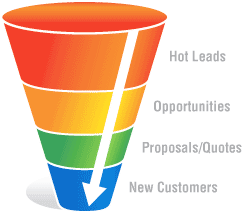Why? Read until the end if you like, but then I risk you prove it wrong, just by reading it?!
This post will indicate some dangers to avoid when optimizing sales processes.
If you are professionally involved in sales process, you must have already stumbled upon the concept of a sales funnel. Either you were asked to design or manage a sales process or you were reminded by a boss about your priorities and responsibilities using a diagram of a sales funnel.
In short we can say that a sales funnel is a model of a sales process which defines sequential steps that are required to extract revenue from a given market potential. The model strives to be optimal in the sense of revenue versus sales costs index. In other words, the model shows how much effort should be invested at a given stage of a sales process to maximize the overall revenue gain.
A typical sales funnel has a shape of a cone. An example is illustrated in the image on the right. It is wider at the top and gets narrower as we move down. The top of the funnel is abstract and strategic, the bottom is objective and tactical; the top deals with (almost) infinite number of instances, the bottom deals with relatively small number of instances; the top is handled by marketing departments, the bottom is handled by sales departments.
The cone shape of a sales funnel tells us that in order to be optimal we should address a wide audience at the top, but spend relatively little per each instance. On the other hand, we should carefully select a smaller subset of instances at the top and spend progressively more per instance as we move down the funnel.
There are numerous indicators which describe the properties of a sales funnel. I would like to point out one such indicator to show how misleading sometimes a very straightforward goal to optimize a sales process is.
Let us take a look at the conversion rate indicator. This indicator tells us what percentage of instaces is moved to the next stage in the sales funnel.
Suppose we have a company with an infinite market, meaning there are more potential sales opportunities than we can theoretically close. In other words, the potential exceeds the capacity of the company.
Consider now this case, "The company claims they have a 100% conversion rate. Is this optimal for the company?"
What does this mean? A 100% conversion rate means that every instance entering the sales funnel is also exiting it at the very bottom when the sales successfully closes the case. This also means a sales funnel is no longer cone shaped, but cylinder shaped structure. This company has a sales cylinder.
Is this good or bad?
It depends upon which cylinder it is. Consider the two diagrams below.

Type A and Type B cylinder shaped sales funnels.
The company may think they have a type A cylinder, but I claim they have a type B cylinder, since type A is theoretically impossible. Remember, there are more sales potentials than the company can service.
This means this company is exposed to huge risk. This does not mean they can close every deal that they pick; this means they have to close every deal to survive. They are suffering from low market awareness, which is why they have to take any deal that comes along. There is no room for optimization. Every deal has to be closed.
If they had a cone shaped sales model, they would have the luxury to pick opportunities and optimize. Sure, their conversion rate would be less than 100%, but that is good. That would give them the leverage to optimize.
A cylinder shape would only be acceptable in cases where the market potential is small. Meaning the company has the capacity to theoretically service all the customers in the market. But then again, that case is not very interesting by its definition.
Therefore, when optimizing a sales process, analyze all stages. Remember, your prospects have to come from somewhere, and some of your leads have to be positively closed to have a successful sales process.
Do not overoptimize! Some instances will fall out of the process and that is good!
Closing disclaimer: I hope not every one of you is reading this, as this would prove the post is meaningless.


2 comments:
I hereby confess I read it to the end.Need to optimize time investment.Cheers.franci
Matjaz,
Interesting article, I am afraid that I have read it all.
May I ask a question to you: In the industry or market that you operate, I wonder if there is an optimum ratio between number of instances at top of the cone, perhaps one upper level (i.e. Prospects) and bottom of the cone (New customers)
Kind regards,
Mustafa Duran
Post a Comment